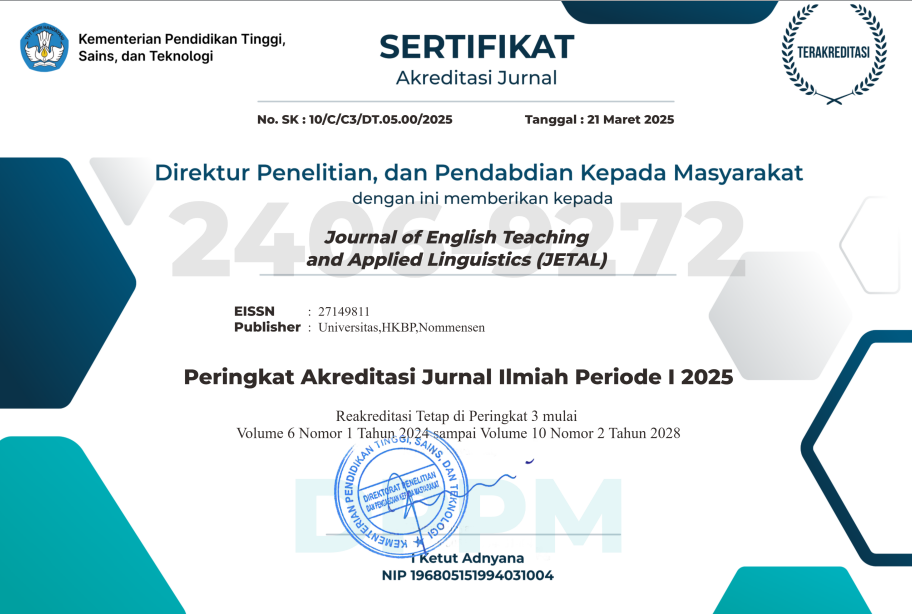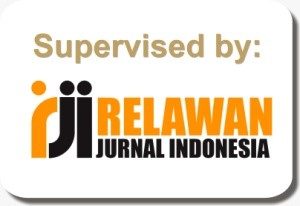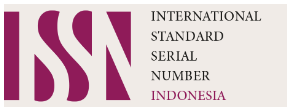Student’s Difficulties in Using Transition Signals in Writing Descriptive Paragraph of The Second Year Students of SMP Gajah Mada Medan
Abstract
This study attempt to discuss student’s difficulties use transition signals when writing descriptive paragraph of SMP Gajah Mada Medan sophomores. The subject of the research is to know the types of transition signals that are difficult for the students to use in writing descriptive paragraphs. The researcher wants to discover the dominant types of transitional signs that are difficult for students to use when writing descriptive paragraphs. The population for the research was 18 second-years SMP Gajah Mada Medan students. The study used descriptive qualitative research. The result of the research showed that there were four types of students’ difficulties in using transition cues when writing descriptive paragraphs, namely: additional idea, opposite idea or contrast, example and cause effect. The dominant type of transition signals that are difficult for students to use when writing descriptive paragraphs was cause and effect with 9 cases (33,3%). This thesis is suggested to students and teachers of the English department as a source of valuable knowledge and information on students’ difficulties in using transition signals.
References
Agustin, M., Norahmi, M., & Asi, N. (2022). An Analysis of Students’ Difficulties in Writing Descriptive Texts in the Tenth Grade of SMA Kristen Palangka Raya. EBONY: Journal of English Language Teaching, Linguistics, and Literature, 2(2), 55–64. https://doi.org/10.37304/ebony.v2i2.5281
Ariadi, F. (2017). The Students’ ability in using Transition Signals in Completing Paragraph. University of Muhhammadiyah Sumatera Utara.
Brown. (2007). Principles of Language Learning and Teaching . NewJersey: Prentice-Hall, in.
Harahap, A.M. (2017). Students’ Error Annalysis in Transisitional Signals at seventh T81-4 IAIN Padang Sidepuan. Tarbiyah and Teaching Training Faculty/English H. Education Department.
Kasim. N.A., Mohamed. G.M., Nuawi. M.Z.B. (2021). Prediction of the Second Transition Point of Tool Wear Phase Using Vibratory Signal Analysis (ZROT). International ABEC 2021: Proceeding International Applied Business and Engineering Conference 2021. International ABEC
Mayasari. E. (2018). The Contribution Of Clustering Technique In Developing Ideas On A Short Paragraph For The First Year English Education Students Of Stai Miftahul Ulum Tanjungpinang. Universitas Muhammadiyah Makassar. DOI: 10.26618/exposure.v7i2.1609
Murniati. (2022) An Analysis Of Students Writing Ability In Using Transition Signal In Descriptive Paragraph At Eighth Grade Of Smp Islam Terpadu Dhu’afa Merangin Academic Year 2021/2022. Inovish Journal. DOI: 10.35314/inovish.v7i2.2844
Nikmah, M. (2019). An Error Annalysis on Using Transition Signals in Essay Writing Among the Fourth Semester students of English Education Department in State Indtitte for Islamic Studies Metro. Metro: Institite for Islamic Studies Metro.
Rianti, R. (2020). The ability of PBI students in using transition signals in paragraph writing. Banda Aceh: Universitas Islam Negeri Ar-Raniry Banda.
Ota, Maria K. (2018). Developing Communicative Learning Materials for Teaching English as a Foreign Language to Students of Elementary Teacher Study Program of Flores University of East Nusa Tenggara. Universitas Pendidikan Ganesha. DOI: 10.23887/jpbi.v6i1.2707
Rachmawati. D.I., Jurianto. J. (2020). Investigating English Department Students’ Foreign Language Speaking Anxiety: A Case Study In Universitas Airlangga, Indonesia. Universitas PGRI Madiun. DOI: 10.25273/she.v1i2.6624
Sari, D. (2018). The Use of Transition Signals in Writing Essay at the Fifth Semesetr Students og English Department in Muhammadiyah University of Mkasaar. Makassar: University of Makassar.
Udin, M. (2018). Reading Comprehension: A Study on the Correlation between Grammar and Logic. Langua: Journal of Linguistics, Literature, and Language Education, 1(1), 62–72. https://doi.org/https://doi.org/10.5281/zenodo.1415299
Authors retain copyright and grant the journal right of first publication with the work simultaneously licensed under a Creative Commons Attribution-ShareAlike 4.0 International License (CC BY-SA 4.0) that allows others to share the work with an acknowledgment of the work's authorship and initial publication in this journal.
Authors are able to enter into separate, additional contractual arrangements for the non-exclusive distribution of the journal's published version of the work (e.g., post it to an institutional repository or publish it in a book), with an acknowledgment of its initial publication in this journal.
Authors are permitted and encouraged to post their work online (e.g., in institutional repositories or on their website) prior to and during the submission process, as it can lead to productive exchanges, as well as earlier and greater citation of published work (See The Effect of Open Access).






